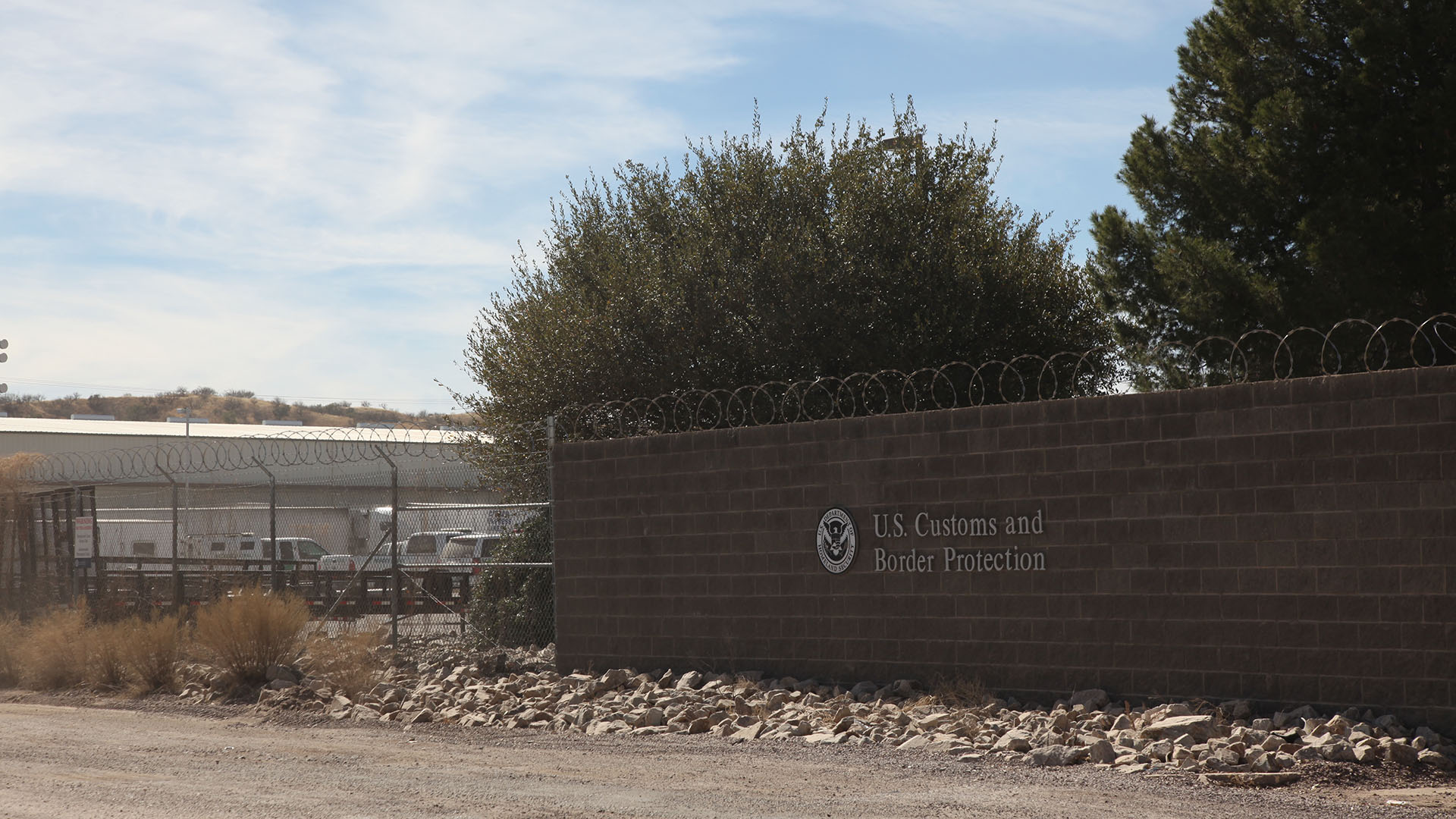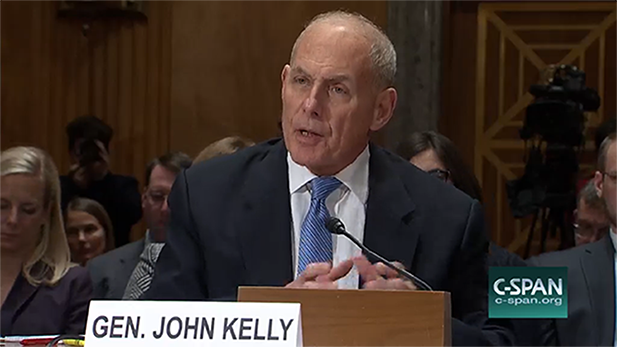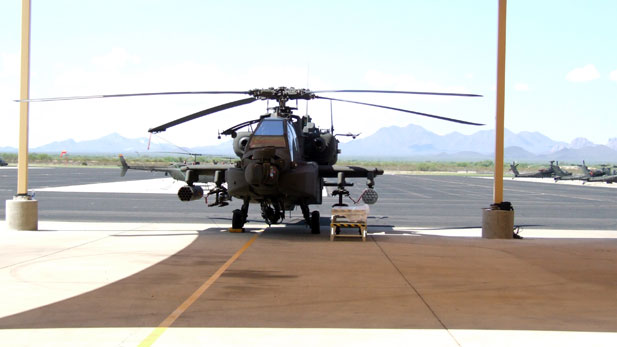 A fence at the Border Patrol Nogales Station.
A fence at the Border Patrol Nogales Station.
The Trump administration is considering a proposal to mobilize as many as 100,000 National Guard troops in Arizona and other states to round up unauthorized immigrants, including millions living nowhere near the Mexico border, according to a draft memo obtained by The Associated Press.
The 11-page document, the full text of which is below, calls for the unprecedented militarization of immigration enforcement as far north as Portland, Oregon, and as far east as New Orleans.
"That is 100 percent not true. It is false," White House Press Secretary Sean Spicer told reporters aboard Air Force One, calling the AP’s report that Trump may call up as many as 100,000 troops "irresponsible."
Four states that border on Mexico are included in the proposal — California, Arizona, New Mexico and Texas — and it encompasses seven states contiguous to those four — Oregon, Nevada, Utah, Colorado, Oklahoma, Arkansas and Louisiana.
 Retired Marine Corps General John Kelly, the Homeland Security Secretary nominee during his more than two-hour-long confirmation hearing.
Retired Marine Corps General John Kelly, the Homeland Security Secretary nominee during his more than two-hour-long confirmation hearing.Governors in the 11 states would have a choice whether to have their guard troops participate, according to the memo, written by U.S. Homeland Security Secretary John Kelly, a retired four-star Marine general.
A spokesman for Arizona Gov. Doug Ducey said the governor was unaware of the proposal. Ducey was scheduled to be in Tucson Friday to tour an elementary school.
While National Guard personnel have been used to assist with immigration-related missions on the U.S.-Mexico border before, they have never been used as broadly or as far north.
The memo is addressed to the then-acting heads of U.S. Immigration and Customs Enforcement and U.S. Customs and Border Protection. It would serve as guidance to implement the wide-ranging executive order on immigration and border security that President Donald Trump signed Jan. 25. Such memos are routinely issued to supplement executive orders.
Also dated Jan. 25, the draft memo says participating troops would be authorized "to perform the functions of an immigration officer in relation to the investigation, apprehension and detention of aliens in the United States." It describes how the troops would be activated under a revived state-federal partnership program, and states that personnel would be authorized to conduct searches and identify and arrest any unauthorized immigrants.
The draft document has circulated among DHS staff over the last two weeks. As recently as Friday, staffers in several different offices reported discussions were underway.
If implemented, the impact could be significant. Nearly one-half of the 11.1 million people residing in the U.S. without authorization live in the 11 states, according to Pew Research Center estimates based on 2014 Census data.
Use of National Guard troops would greatly increase the number of immigrants targeted in one of Trump's executive orders last month, which expanded the definition of who could be considered a criminal and therefore a potential target for deportation. That order also allows immigration agents to prioritize removing anyone who has "committed acts that constitute a chargeable criminal offense."
Under current rules, even if the proposal is implemented, there would not be immediate mass deportations. Those with existing deportation orders could be sent back to their countries of origin without additional court proceedings. But deportation orders generally would be needed for most other unauthorized immigrants.
The troops would not be nationalized, remaining under state control.
The proposal would extend the federal-local partnership program that President Barack Obama's administration began scaling back in 2012 to address complaints that it promoted racial profiling.
The 287(g) program, which Trump included in his immigration executive order, gives local police, sheriff's deputies and state troopers the authority to assist in the detection of immigrants who are in the U.S. illegally as a regular part of their law enforcement duties on the streets and in jails.
The draft memo also mentions other items included in Trump's executive order, including the hiring of an additional 5,000 border agents, which needs financing from Congress, and his campaign promise to build a wall between the U.S. and Mexico.
The signed order contained no mention of the possible use of state National Guard troops.
According to the draft memo, the militarization effort would be proactive, specifically empowering Guard troops to solely carry out immigration enforcement, not as an add-on the way local law enforcement is used in the program.
Allowing Guard troops to operate inside non-border states also would go far beyond past deployments.
In addition to responding to natural or man-made disasters or for military protection of the population or critical infrastructure, state Guard forces have been used to assist with immigration-related tasks on the U.S.-Mexico border, including the construction of fences.
In the mid-2000s, President George W. Bush twice deployed Guard troops on the border to focus on non-law enforcement duties to help augment the Border Patrol as it bolstered its ranks. And in 2010, then-Arizona Gov. Jan Brewer announced a border security plan that included Guard reconnaissance, aerial patrolling and military exercises.
In July 2014, then-Texas Gov. Rick Perry ordered 1,000 National Guard troops to the border when the surge of migrant children fleeing violence in Central America overwhelmed U.S. officials responsible for their care. The Guard troops' stated role on the border at the time was to provide extra sets of eyes but not make arrests.
 An idle National Guard Apache helicopter, September 2012.
An idle National Guard Apache helicopter, September 2012.Bush initiated the federal 287(g) program — named for a section of a 1996 immigration law — to allow specially trained local law enforcement officials to participate in immigration enforcement on the streets and check whether people held in local jails were in the country illegally. ICE trained and certified roughly 1,600 officers to carry out those checks from 2006 to 2015.
The memo describes the program as a "highly successful force multiplier" that identified more than 402,000 "removable aliens."
But federal watchdogs were critical of how DHS ran the program, saying it was poorly supervised and provided insufficient training to officers, including on civil rights law. Obama phased out all the arrest power agreements in 2013 to instead focus on deporting recent border crossers and immigrants in the country illegally who posed a safety or national security threat.
Trump's immigration strategy emerges as detentions at the nation's southern border are down significantly from levels seen in the late 1990s and early 2000s. Last year, the arrest tally was the fifth-lowest since 1972.
Deportations of people living in the U.S. illegally also increased under the Obama administration, though Republicans criticized Obama for setting prosecution guidelines that spared some groups from the threat of deportation, including those brought to the U.S. illegally as children.
Last week, ICE officers arrested more than 680 people around the country in what Kelly said were routine, targeted operations; advocates called the actions stepped-up enforcement under Trump.



By submitting your comments, you hereby give AZPM the right to post your comments and potentially use them in any other form of media operated by this institution.